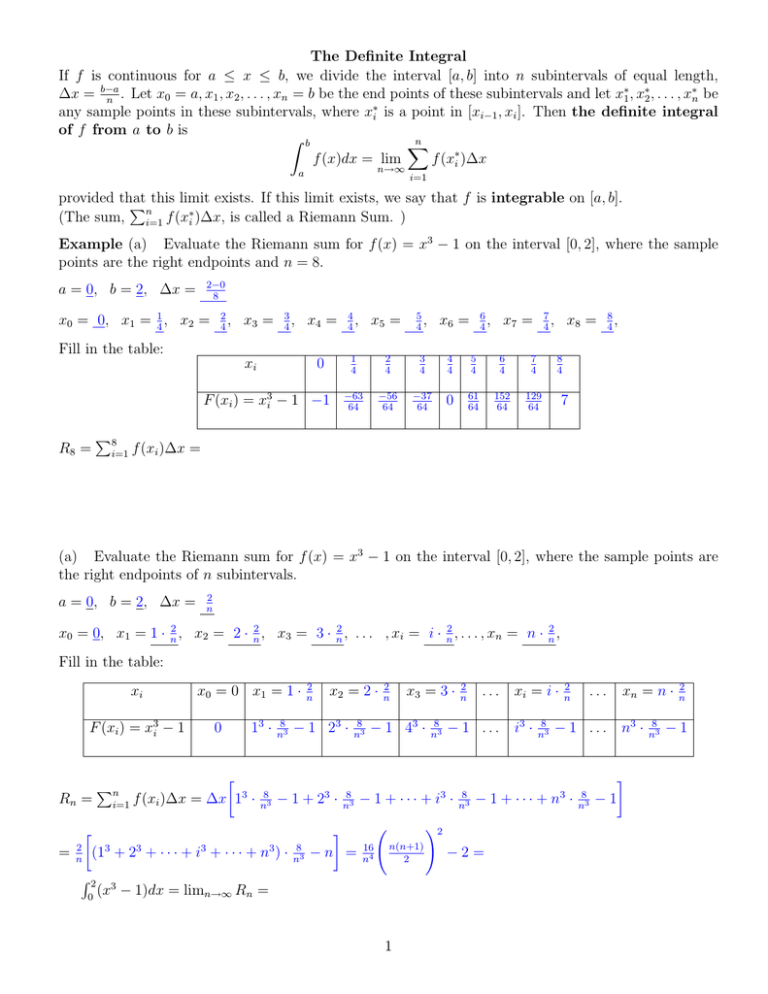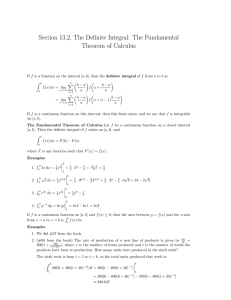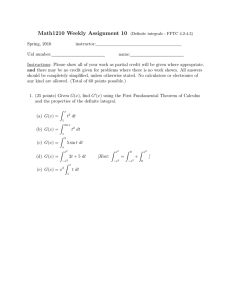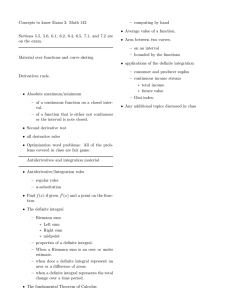Definite Integral: Riemann Sums & Properties
advertisement

The Definite Integral If f is continuous for a ≤ x ≤ b, we divide the interval [a, b] into n subintervals of equal length, ∆x = b−a . Let x0 = a, x1 , x2 , . . . , xn = b be the end points of these subintervals and let x∗1 , x∗2 , . . . , x∗n be n any sample points in these subintervals, where x∗i is a point in [xi−1 , xi ]. Then the definite integral of f from a to b is Z b n X f (x)dx = lim f (x∗i )∆x n→∞ a i=1 provided that this limit exists. If this limit exists, we say that f is integrable on [a, b]. P (The sum, ni=1 f (x∗i )∆x, is called a Riemann Sum. ) Example (a) Evaluate the Riemann sum for f (x) = x3 − 1 on the interval [0, 2], where the sample points are the right endpoints and n = 8. 2−0 8 a = 0, b = 2, ∆x = x0 = 0, x1 = 14 , x2 = 2 , 4 x3 = 3 , 4 x4 = 4 , 4 x5 = 5 , 4 0 1 4 2 4 3 4 4 4 5 4 6 4 7 4 −63 64 −56 64 −37 64 0 61 64 152 64 129 64 Fill in the table: xi F (xi ) = x3i − 1 −1 P8 R8 = i=1 6 , 4 x6 = 7 , 4 x7 = x8 = 8 , 4 8 4 7 f (xi )∆x = (a) Evaluate the Riemann sum for f (x) = x3 − 1 on the interval [0, 2], where the sample points are the right endpoints of n subintervals. a = 0, b = 2, ∆x = 2 n x0 = 0, x1 = 1 · n2 , x2 = 2 · n2 , x3 = 3 · n2 , . . . , xi = i · n2 , . . . , xn = n · n2 , Fill in the table: xi F (xi ) = x3i − 1 Rn = = 2 n Pn i=1 x0 = 0 x1 = 1 · 13 · 0 f (xi )∆x = ∆x 13 · 8 n3 8 n3 0 x2 = 2 · − 1 23 · − 1 + 23 · (13 + 23 + · · · + i3 + · · · + n3 ) · R2 2 n 8 n3 8 n3 8 n3 −n = 2 n x3 = 3 · − 1 43 · 8 n3 2 n ... − 1 ... − 1 + · · · + i3 · 8 n3 n(n+1) 2 (x3 − 1)dx = limn→∞ Rn = 1 i3 · 8 n3 2 n −2= ... − 1 ... − 1 + · · · + n3 · !2 16 n4 xi = i · 8 n3 xn = n · n3 · −1 8 n3 2 n −1 Net Signed Area We saw in the previous section that if f (x) > 0 is a continuous function on the interval [a, b], then the definite integral Z b f (x)dx = lim n X n→∞ a f (x∗i )∆x = A (where ∆x → 0 as x → 0) i=1 gives the area under the curve y = f (x) over the interval [a, b]. When f (x) has both positive and negative values on the interval [a, b], the definite integral Z b f (x)dx = lim n→∞ a n X f (x∗i )∆x = A1 − A2 (where ∆x → 0 as x → 0) i=1 11 gives the net area or net signed area, A1 − A2 , where A1 is sum of the areas of the regions between the graph of f (x) and the x− axis which are above the x-axis and A2 is the sum of the areas of the regions between the graph of f (x) and the x− axis which are below the x-axis. 10 9 8 Example In the case of f (x) = x3 − 1 on the interval [0, 2], the graph is shown below: 7 6 5 f(x) = x3 – 1 4 3 2 1 –4 –2 A1 A2 2 4 6 8 –1 Example Using the net signed area interpretation of the definite integral and geometry to evaluate the following definite integrals: Z 1 Z 1 Z 3√ 2 xdx 9 − x dx, xdx, –2 –3 –4 −3 –5 0 –6 2 −1 It is important to be able to recognize the definite integral when we encounter it, because we will develop useful methods by which we can calculate the definite integral without taking limits of Riemann sums later. Example Express the following limit of Riemann sums as a definite integral: lim n→∞ n X sin xi i=1 xi ∆x, [π, 2π]. where xi = π + i∆x and ∆x = πn . Integrability As it turns out all continuous functions on an interval [a, b] are integrable, in fact if a function has just a finite number of jump discontinuities on an interval [a, b], it is integrable on [a, b]. Theorem If f is continuous on [a, b] or if f has only a finite number of jump Rb discontinuities on [a, b] , then f is integrable on [a, b], that is the definite integral a f (x)dx exists and Z b n X f (x)dx = lim f (xi )∆x n→∞ a where ∆x = b−a n and i=1 xi = a + i∆x. Note R b that the sum for which the limit above is calculated is Rn , the right endpoint approximation to f (x)dx. We could equally well use the limit of the left endpoint approximation or the midpoint a approximation. In fact if the value of a definite integral is unknown, the midpoint approximation is frequently used to approximate it. We will study other methods of approximation in Calculus 2 Midpoint Rule If f is integrable on [a, b], then Z b f (x)dx ≈ Mn = a n X f (x̄i )∆x = ∆x(f (x¯1 ) + f (x¯2 ) + · · · + f (x¯n )), i=1 where ∆x = b−a n and 1 xi = a + i∆x and x̄i = (xi−1 + xi ) = midpoint of [xi−1 , xi ]. 2 R 2π Example Use the midpoint rule with n = 4 to approximate 0 sin( x2 )dx. Fill in the tables below: ∆x = 2π−0 = π2 4 xi x0 = 0 x1 = π2 x2 = π x3 = 3π x4 = 2π 2 x̄i = 12 (xi−1 + xi ) f (x̄i ) = sin x¯2i M4 = P4 1 f (x̄i )∆x = sin π8 + sin 3π + sin 5π 8 8 x¯1 = π4 x¯2 = 3π x¯3 = 5π x¯4 = 7π 4 4 4 sin π8 sin 3π sin 5π sin 7π 8 8 8 + sin 7π ∆x = 0.3827 + 0.9239 + 0.9239 + 0.3827 π2 ≈ 4.1048 8 3 Properties of the Definite Integral If f and g are integrable functions on [a, b] (in particular if they are continuous) and if c is a constant, we have the following properties of the definite integrals: Rb Ra 1. Order of integration: f (x)dx = − b f (x)dx. a Ra 2. Zero Width Interval: f (x)dx = 0. a Rb 3. Integral of a constant: cdx = c(b − a) a Rb Rb 4. Constant multiple: cf (x)dx = c a f (x)dx. a Rb Rb Rb 5. Sum and Difference: f (x) ± g(x)dx = a f (x)dx ± a g(x)dx. a Rb Rb Rc 6. Additivity: a f (x)dx + c f (x)dx = a f (x)dx. 7. Min-Max inequality: If f has maximum value M on [a, b] and minimum value m on [a, b], then Z b m(b − a) ≤ f (x)dx ≤ M (b − a). a 8. Domination: if f (x) ≥ g(x) for all x in [a, b], then Rb if f (x) ≥ 0 for all x in [a, b], then a f (x)dx ≥ 0. Rb a f (x)dx ≥ Rb a g(x)dx. Example Recall that we have calculated the following integrals using limits of Riemann sums or geometry: Z 2 3 Z 3 (x − 1)dx = 2, 0 −3 √ 9− x2 dx 9π = , 2 4 Z 0 1 2 (1 − x )dx = , 3 2 Z 0 1 1 xdx = . 2 Using these results to evaluate the following integrals: R1 (a) 0 x2 dx (note 1 − (1 − x2 ) = x2 .) (b) R1 (c) R −3 √ (d) R1 0 3x2 + 2x + 5dx. 3 9 − x2 dx (x3 − 1)dx + 0 R2 1 (x3 − 1)dx (e) Use property 7 to find upper and lower bounds for the definite integral Z 2 1 − x3 + cos(10x) dx 0 (f) Find R1 1 x100 + x2 + 35 dx (g) Use property 8 to find a lower bound for R3 √ −3 9 − x2 + x4 + x6 dx. Old Exam Questions Exam 3 Fall 2007 : # 6, 10, Exam 3 Fall 2008 : # 7, 10, 11(a), 5







